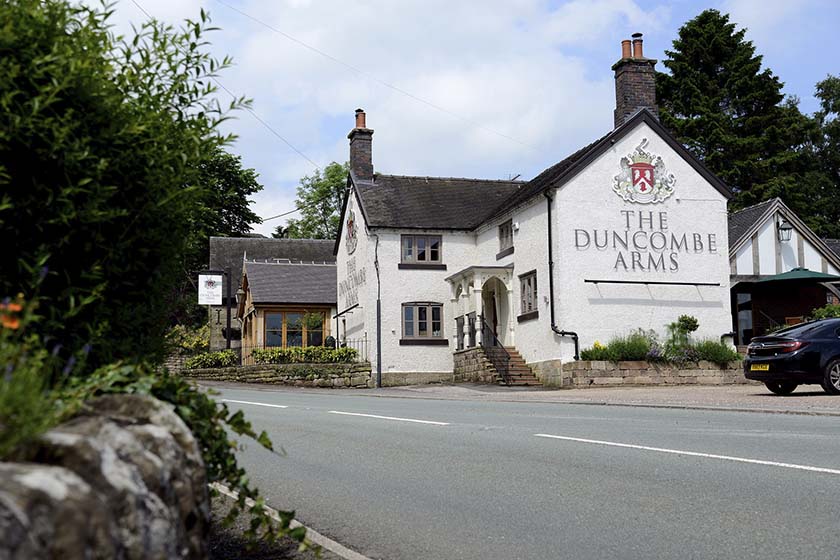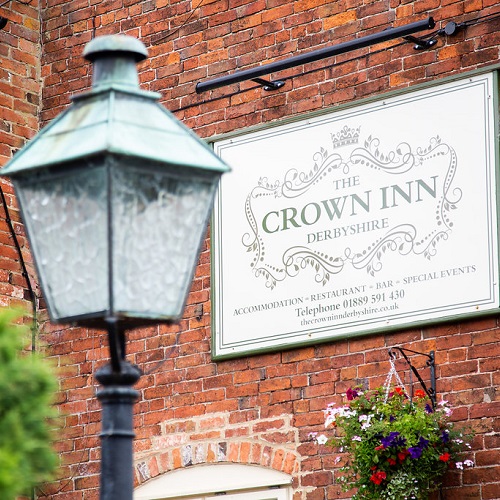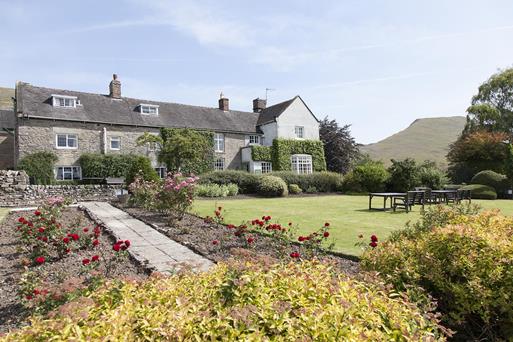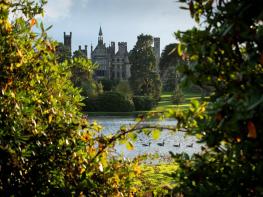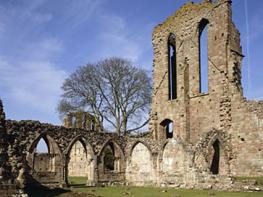In the rural village of Ellastone, The Duncombe Arms has gained a strong following since being…
Ellastone and Calwich Abbey

Discover the area that was the source of inspiration for an infamous author and a famous composer.
4 miles (6.4kms)
About the walk
Ellastone, near the Derbyshire border to the southwest of Ashbourne, is known for its literary and musical associations, both of which involve people named George, or so it would seem. The first is George Eliot, author of – among others – Silas Marner (1861) and Middlemarch (1871). Eliot's first novel Adam Bede is based on the village of Ellastone; in the book it is referred to as Hayslope, while Staffordshire is named Loamshire. When it was first published in 1859, by a completely unknown author, a number of impostors tried to claim authorship of the book. Only then was it revealed that George Elliot was a pen name for Marian Evans, who wrote for the prestigious Westminster Review.
A Victorian scandal
The scandal that broke when it was discovered that George Eliot was a woman was exacerbated by the fact that she was also having an extramarital affair with George Henry Lewis, her editor. Unable to divorce his faithless wife, George Henry entered into a common-law marriage with George Eliot. Polite Victorian society was far too conservative for such sordid behaviour, and the author was ostracised by her family and friends. This rejection became one of the themes of her next novel, The Mill on the Floss, published in 1860.
Reflecting the real world
As for Adam Bede, its success then, as now, lay in Eliot's ability to reflect everyday life in her characters and the worlds they inhabited. Shunning the romanticism prevalent in the first half of the 19th century, she was one of the first writers to insist on realism, believing that novels should reflect not only the real world, but also some underlying moral purpose above and beyond the entertainment to be had from a good read. In Adam Bede, the hero is thought to have been based heavily on Marian's own father, and in amongst a tragic love story – interlaced with rich descriptions of rural life – lies the novel's central theme, that selflessness is the secret of happiness.
A great composer
The second George to find inspiration in Ellastone was George Frideric Handel (1685–1759), who was later described by Beethoven as the 'the greatest composer who ever lived'. Handel's most famous work is arguably The Messiah, which he composed in a furious 24 days while staying with friends at Calwich Abbey in 1741 (Calwich Abbey is passed in the early stages of the walk). The Messiah was first performed, in aid of charity, in Dublin a year later, where it was met with rapturous applause. Some years later, King George II was so moved on hearing the Hallelujah Chorus that he rose to his feet; the audience duly followed his example and the tradition remains today, even in the absence of royalty.
Walk directions
From the former post office, opposite the red post box, go left and then take the first left down an obvious gravel track. Keep going straight to Calwich Abbey. Follow the track left of the abbey and along the metalled road as far as Calwich Home Farm.
Pass the farm and follow the track round to the left of The Grove and through a gate. At the fork go left, through another gate and down a slope and, after 50yds (46m), veer left off the track up a short hill to a stile in front of Cockley farm. Cross the stile and head just to the right of Cockley, following a dirt and grass track all the way to the B5032.
At the road go left and then first right, through Calwich Bank Farm and up a gravel track. When the track bears round to the right, keep going straight into a field, making for a gap in the hedge at the top right-hand corner. Go through the gap, over a stile on the left and then follow the hedge left, down the field.
At the bottom follow the hedge round to the left and cut diagonally right across the field to a stile. After crossing the stile, skirt round the top of the wood to another stile and continue as far as The Hutts Farm. After a stile take the gravel track up the hill to a gate into the farmyard and head straight on to another stile into a field.
Continue straight across, making for the corner of Aldercarr Wood ahead to the left. Keep going straight on and down to the far bottom corner of the field, and carry on along the right-hand edge of the next field. At the far end cross another stile and continue straight on (not diagonally left) to the B5032. Turn right along the road and, after 100yds (91m), take the path to the left. Head diagonally right across the field to a double stile and then left round the bottom of a small mound with trees. Keep going as far as the junction of the two bridleways, between Point 1 and Point 2, and from here retrace your steps back to the start.
Additional information
Gravel tracks, roads and grass trails, many stiles
Farmland
Must be kept on lead
OS Explorer 259 Derby
Ample parking along village roads
None on route
WALKING IN SAFETY
Read our tips to look after yourself and the environment when following this walk.
Find out more
Also in the area
About the area
Discover Staffordshire
It was Staffordshire that bore the brunt of the largest non-nuclear explosion of World War II, when a munitions dump at RAF Fauld went up in 1944. It was also the county’s regiment that once boasted within its ranks the most decorated NCO of World War I, in the person of William Coltman (1891-1974). Going back a little further, George Handel penned his world-famous masterpiece The Messiah on Staffordshire soil. During another chapter of Staffordshire history, the county was home to the first canals and the first factory in Britain, and it had front-row seats for the drama surrounding one of the most notorious murder trials of the 19th century, that of Doctor William Palmer.
In outline, Staffordshire looks not unlike the profile of a man giving Leicestershire a big kiss. The man’s forehead is arguably the best region for hillwalking, as it comprises a significant chunk of the Peak District. This area is characterised by lofty moors, deep dales and tremendous views of both. Further south are the six sprawling towns that make up Stoke-on-Trent, which historically have had such an impact on Staffordshire’s fortunes, not to mention its culture and countryside. This is pottery country, formerly at the forefront of the Industrial Revolution and the driving force behind a network of canals that still criss-cross the county.
Nearby stays
Restaurants and Pubs
Nearby experiences
Recommended things to do
Why choose Rated Trips?
Your trusted guide to rated places across the UK
The best coverage
Discover more than 15,000 professionally rated places to stay, eat and visit from across the UK and Ireland.
Quality assured
Choose a place to stay safe in the knowledge that it has been expertly assessed by trained assessors.
Plan your next trip
Search by location or the type of place you're visiting to find your next ideal holiday experience.
Travel inspiration
Read our articles, city guides and recommended things to do for inspiration. We're here to help you explore the UK.


